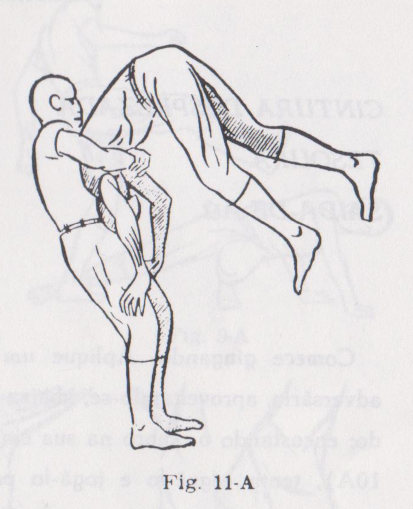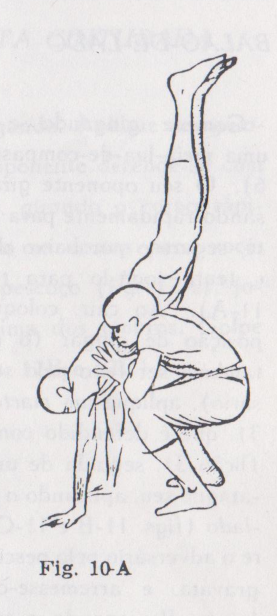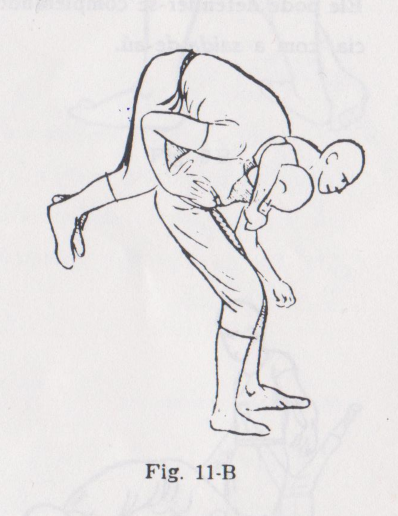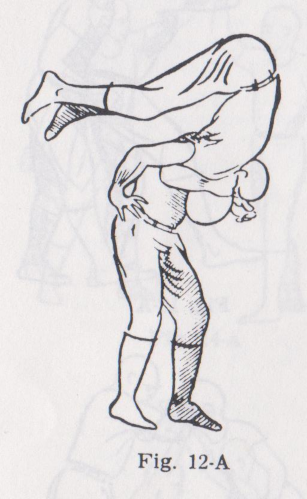
https://www.youtube.com/watch?v=8Ft-YvQV6Rc
Balao cinturado
Balao cinturado is one of the Baloes of Regional; and also one of the four basic ones (Apanhada, Balao cinturado, Balao de lado, Gravata cinturada - called 'Cintura desprezada' sometimes).
Today, thanks to internet and youtube, anybody can find how this technique is executed. (Well, it is still not so easy as Baloes are rare even today; but you can look at my Baloes reference for a video of Balao cinturado).
However, these is still one thing that is a bit mysterious about Balao cinturado: The entry.
Today, you usually see it done from some kind of 'cabeçada'; or even from Boca de calça (Mestre Decanio); which is kind of natural because of the position the opponent has to be in.
However, in the booklet 'Curso de capoeira regional' of Mestre Bimba, Balao cinturado is described to be entered against a MLDC!
This is not so natural; because the only way to apply Cinturado against MLDC is: When the opponent kicks MLDC, quickly run around it and while he is still bent over in the kick, bend over him, seize him under the armpits and throw him.
Note that in order to apply this entry, you have to be able to run around MLDC before it is completed; which is definitely something you do not see in modern capoeira.
In fact, it is not quite easy; which is why this entry is not used in modern capoeira; but we will get back to it.

-
There is something special about this entry - and as it frequently is in Bimba's system, that something special is Nemer.
This entry can only be comfortably done using Nemer: As the opponent throws MLDC with his left leg, switch to Nemer (or go right from Nemer ginga) and as he is bent over, jump over his back with your right leg; turning and grabbing his around the armpits in mid-air as you land. This is all one movement; done using Nemer.
A bonus is that when you seize opponent's waist using Nemer like this, you apply a nerve strangle to him; so you can throw him with Balao cinturado without problems.
However, there is one more bonus to this: If you apply the nerve strangle to the opponent, and then throw him over you using Balao cinturado while the nerve strangle is still going, you change it to nerve confuser - a lot more powerful nerve technique that will make him extremely disoriented for about 20 seconds. (See my work on kungfu for more about nerve confusers)
This is the true power of Bimba's Balao cinturado. We will see the same principle at work in Apanhada. As ever, the key is Nemer.

Apanhada
There is yet another part of Cintura desprezada sequence that is a bit mysterious: The 'Apanhada', where you take opponent's Au on your shoulder and throw him behind you.
Now using today's capoeira, the technique is a bit random - it is hard to tell why it looks the way it does. People place one another on their shoulders gingerly and then jump up a bit and put themselves down...what is going on here?
The key is again Nemer archetype (in Bimba's capoeira, it is either always LightLegs or Nemer ;-). Using Nemer archetype, Apanhada is an evil counter against opponent's Au.
When the opponent does Au, equip Nemer and squat on both feet, with your forearms squeezed in front of your chest, palms forward, palm heels together, fingers to the sides and both elbows supported on your thighs(this is important! See the picture in 'Curso de capoeira Regional).
Move forward in this stance and bump opponent's belly with both your palms as he does the Au; this is a high-energy point("Ho!"). This bump, done using Nemer archetype, applies a nerve strangle to him. However, it gets even better!
As you bump him and nerve strangle him, his Au will collapse and fall down across your right shoulder. Immediately stand up, lifting him by arching back and still pushing leftward with your palms and planting him on his feet behind you; this is high-energy point.
If you apply this maneuver while the nerve strangle is still going (which it usually is!), it again changes into a nerve confuser - the opponent is on his feet, but extremely disoriented for about 20 seconds.
This is the power of true Apanhada; not the poor technique we are used to see. In Apanhada, the opponent is not supposed to willingly lay down on your shoulder; instead, you make him collapse using the double palm strike.
-
Note that the stance used to bump him is important; it must have Nemer archetype and your elbows have to be on your thighs. This creates a good structure the opponent can collapse onto, and you can lift him easily.
-
The only way you can escape the confuser is to keep LightLegs on as the opponent lifts you and plants you on your feet. This is a type of the request-response inherent to Bahian capoeira.
If the opponent escapes(answers) your Apanhada with LightLegs, you can still answer with your own counter: Get on all fours, equip LightLegs and apply a Crawling tesoura; as it was originally done in Bimba's sequence. For description of Crawling tesoura, see my article.
Again, the opponent can answer(escape) with an Au of his own. This is preserved in Bimba's original Cintura desprezada sequence.
Balao de lado
From the above, it is quite straightforward to extrapolate what Bimba's Balao de lado was supposed to do:
As I write in my article on Bimba's chanceries, when you apply side chancery using Nemer archetype, as Bimba did, it creates a nerve disruption in the opponent.
If you then throw him over your hip - as in Balao de lado -with the nerve disruption going, you turn it into a nerve confuser.
(Note that you must throw him as in Balao de lado - with one arm around his neck only; you cannot help the throw with the other arm).

Gravata cinturada
Do I have to spell out what Gravata cintura does?
Again, you seize opponent's head in Nemer over-shoulder chancery; this applies a nerve strangle to him. Then you throw him; which creates a nerve confuser.

Jumping out
Only one question remains - how are you supposed to jump out of these throws, as we are taught today? If you get caught with one of these nerve confusers, it is game over - you will not be able to do anything for about 20 seconds.
There is only one way: After Bimba applies the inital grab and tries to throw you, quickly switch into LightLegs and jump out! This not only allows you to escape the throw, but more importantly, you will escape the nerve confuser!
But that is just about the only way - if you are not able to use LightLegs, you will not jump out; and you will get the nerve confuser.
Note that this is not easy, as you have to LightLegs jump out while being nailed with a nerve disruptor or nerve strangle.
--
Conclusion:
In Bimba's original Nemer capoeira, Apanhada and Balao cinturado are two very powerful counters against Au and MLDC, respectively. Both use Nemer archetype and both cause a nerve confuser if done properly.
They use a special tactics to apply it: You first apply a nerve strangle to the opponent; and then lift him off the ground and put him back down. For some reason, this creates a nerve confuser.
Balao de lado and Gravata cinturada work very similarly; you use Nemer to apply a chancery to the opponent (applying nerve strangle or disruption); then throw him to apply a nerve confuser.
It is clear that the four basic 'Cinturas desprezadas' of Bimba were in reality nerve confuser-inducing throws.
You were supposed to use LightLegs to escape the nerve confuser.
-
Just do not ask me how these two powerful techniques changed into what we see today. It is probable that Bimba was simply unable to teach the Nemer archetype to his students; so they were left with simulacra, while only Bimba could do the original techniques.
IMPORTANT NOTE!
Nerve confusers are no so innocent techniques, as the shock to opponent's nerve system is quite severe. Doing two nerve confusers in a row (doing a second one while the first one is still going) might result in a loss of consciousness; doing three nerve confusers in a row might result in opponent dying from a nerve shock!
This is not a joke; after applying nerve confuser, always wait for at least 30 seconds before applying a next one!
---
Note:
Mestre Itapoan in this video
https://www.youtube.com/watch?v=GdkXa11UsDQ
says that "these (cintura desprezada) must be preserved without distortions"...
Yet, the first distortion was made by Bimba's students themselves! As I write above, in true Bimba's Cintura desprezada, the following was supposed to be done:
-Apanhada was a counter against Au, done using Nemer archetype, and caused a nerve confuser
-the following tesoura was done using LightLegs (see my description of Crawling tesoura)
-Balao cinturado was entered using Nemer jump, against MLDC, and caused nerve confuser
-Balao de lado was entered using Nemer side chancery, causing a nerve disruption (see my article on Bimba's chanceries); then throw him to cause nerve confuser
-Gravata cinturada was entered using Nemer over-shoulder chancery, causing a nerve strangle; then throw him to cause nerve confuser
-the jumps out of the Baloes themselves were done using LightLegs
As usual with Bimba, it was all Nemer and LightLegs!
-
Note that the other Regional Baloes - outside of the basic four - do not work like that; ie they do not cause nerve confuser, they are 'just' throws. Was this the reason Bimba taught the four nerve confusers separatedly as 'Cintura desprezada'?
-
Note that the above finally wraps up Bimba's Nemer system as a hard-hitting, crushing capoeira - these are not just some flamboyant acrobatics you demonstrate to your friends; these are powerful nerve confusers, done in Bimbas fashion in a style of throws. You grab your opponent - in the roda or outside - and nerve strangle him; then throw him to apply a nerve confuser; so you can finish him at will.
-
PS: After some time, I found out that even the Baloes of Angola were designed to cause a nerve confuser if you did not escape with LightLegs jump(see the article); so Bimba just continued in the tradition of old Capoeiragem with his Cintura desprezada.
This Web Page was Built with PageBreeze Free HTML Editor